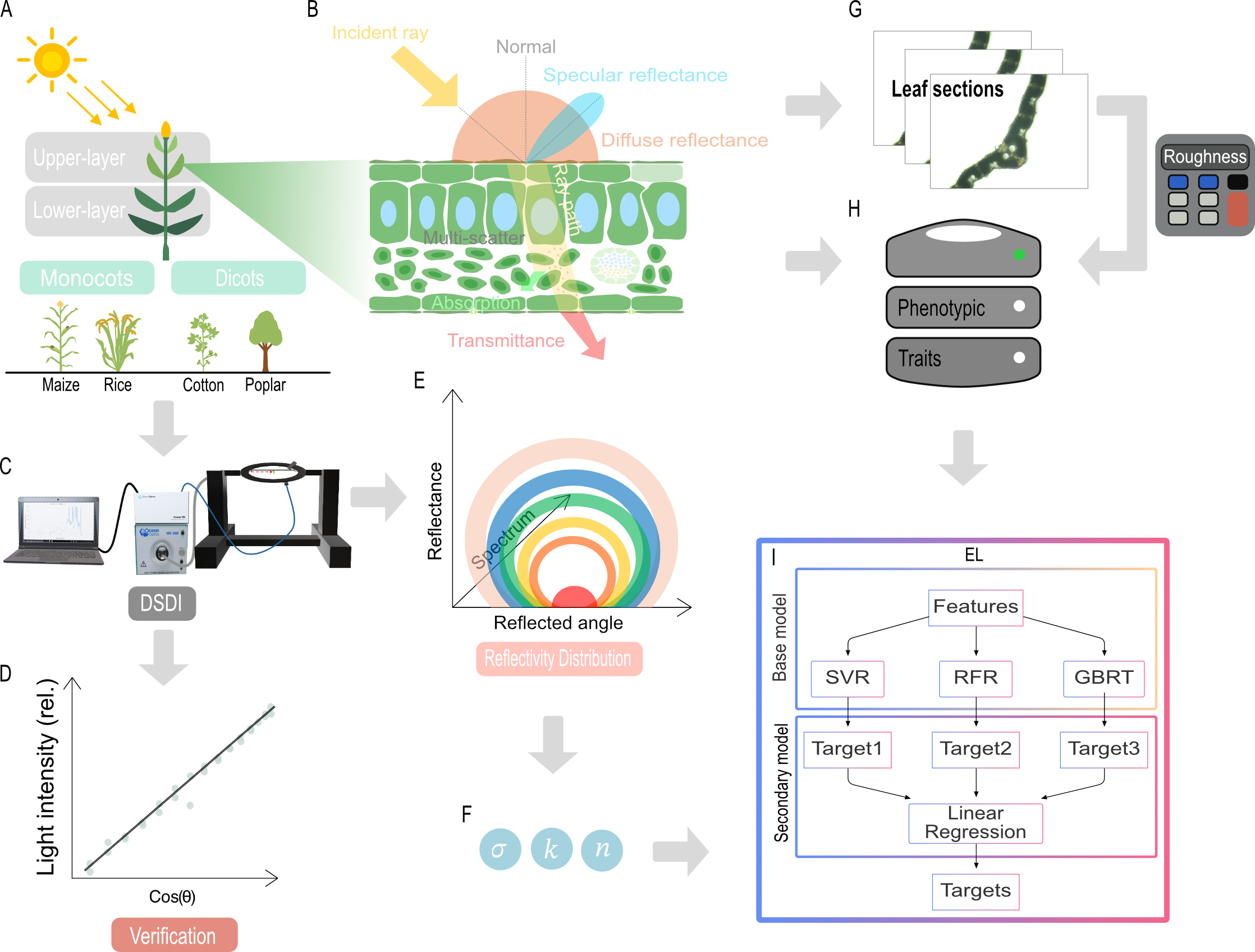Predicting Leaf Optical Properties with BRDF and Phenotypic Traits
Overview

Light distribution within crop canopies determines how efficiently plants convert sunlight into biomass. Our latest study presents a new framework that links leaf anatomy and physiology to optical properties, providing a pathway toward predictive modeling of canopy photosynthesis.
We developed a novel Directional Spectrum Detection Instrument (DSDI) and an ensemble learning (EL) model that accurately predict Bidirectional Reflectance Distribution Function (BRDF) parameters from measurable phenotypic traits.
This work integrates optical physics, phenotyping, and data-driven modeling to enable computational quantification of leaf optical diversity—a key step toward designing crop canopies with higher light-use efficiency.
Key Contributions
- DSDI hardware captures directional spectra (400–1000 nm) with high angular resolution (−π/36 to 35π/36) and R² > 0.99 calibration accuracy.
- Cook–Torrance BRDF fitting pipeline retrieves σ(λ), k(λ), n(λ) from measured data using adaptive grid search + least squares.
- Ensemble learning stack (SVR + RFR + GBRT) predicts BRDF parameters directly from phenotypic traits with R² up to 0.99.
- Ray-tracing integration propagates predicted BRDF into canopy simulations, quantifying how optical diversity reshapes light fields.
Why This Research Matters
Traditional canopy photosynthesis models assume uniform leaf optical properties, which limits prediction accuracy. However, real leaves differ in structure, pigment composition, and surface roughness—factors that shape how light is reflected and transmitted.
Our study shows that leaf optical parameters can be predicted from phenotypic traits, such as:
- Leaf thickness
- Specific leaf weight
- Chlorophyll and carotenoid content
- Surface roughness (quantified microscopically)
This makes it possible to integrate real biological variability into radiative transfer models, improving predictions of canopy microclimate and photosynthetic efficiency.
The DSDI System: Measuring Leaf Reflectance in All Directions
We designed and built the DSDI (Directional Spectrum Detection Instrument) to capture how leaves reflect light at multiple angles and wavelengths (400–1000 nm). The system:
- Uses a high-power xenon light source and a fiber spectrometer;
- Rotates both the light source and the detector mechanically to achieve wide angular coverage (−π/36 to 35π/36);
- Calibrates reflectance with a Lambertian whiteboard standard.
Validation showed that DSDI achieved R² > 0.99 when measuring standard surfaces, ensuring high accuracy in directional reflectance measurement.
Modeling Leaf Reflectance with BRDF
We used the Cook–Torrance BRDF model, a physically based framework describing both specular and diffuse reflections.
Three key parameters define leaf optical behavior:
| Parameter | Description | Biological Meaning |
|---|---|---|
| σ(λ) | Surface roughness | Microscopic unevenness of epidermal surface |
| k(λ) | Diffuse reflection coefficient | Proportion of diffuse vs. specular reflection |
| n(λ) | Refractive index | Light attenuation within leaf tissues |
These parameters were fitted to DSDI data using adaptive grid search and least-squares optimization, achieving R² > 0.95 between model and measured reflectance.
Linking Leaf Traits and Optical Properties
Across four species—maize, rice, cotton, and poplar—we quantified both leaf anatomy and BRDF parameters for upper and lower canopy layers.
Key Findings
- Rice and cotton exhibited higher surface roughness (σ) and more diffuse reflectance;
- Maize and poplar had smoother surfaces and stronger specular peaks;
- Diffuse reflection coefficient (k) increased with wavelength, especially in the NIR region;
- Refractive index (n) negatively correlated with leaf thickness and density (SLW).
These results reveal species-specific optical adaptations, providing new insights for canopy design in breeding programs.
Ensemble Learning Model for Optical Prediction
To connect measurable phenotypic traits with BRDF parameters, we trained an ensemble learning model combining:
- Support Vector Regression (SVR)
- Random Forest (RFR)
- Gradient Boosting Regression Tree (GBRT)
The stacked model achieved R² = 0.83–0.99 across parameters, establishing the first predictive link between leaf phenotypes and optical properties.
This approach transforms leaf optical measurement from a labor-intensive process into a data-driven prediction task—a scalable solution for high-throughput phenotyping.
Simulating Canopy Light Distribution
We incorporated the predicted BRDF parameters into a ray-tracing canopy model (based on fastTracer) to simulate light scattering in rice canopies.
Results showed that changing k(λ), σ(λ), n(λ) significantly altered canopy-level light fields:
- Higher k increased diffuse scattering and light uniformity;
- Lower σ enhanced specular peaks;
- Variation in n influenced internal reflection intensity.
These findings highlight how leaf optical diversity shapes whole-canopy light environments and photosynthetic potential.
Implications
This study establishes a phenomics-oriented framework that connects microscopic structure, biochemistry, and macroscopic optical behavior. It provides:
- A new instrument (DSDI) for angular light measurement,
- A computational method to predict optical traits from phenotypic data,
- A bridge between phenotyping and photosynthesis modeling.
By enabling optical trait prediction across species and environments, this work advances the digital crop phenotyping paradigm—moving from measurement to simulation and prediction.
Citation
Deng, L., Yu, L. X., Mao, L., Wang, Y., Guo, X., Wang, M., Zhang, Y., Song, Q., Zhu, X.-G. (2025).
Leaf Optical Properties Predicted with BRDF and Phenotypic Traits in Four Species: Development of Novel Analysis Tools.
Plant Phenomics. https://doi.org/10.1016/j.plaphe.2025.100135
Resources
Author: Liangchao Deng, Shihezi University / CAS-CEMPS
Part of the Digital Crop Photosynthetic Phenotyping Platform Project.
